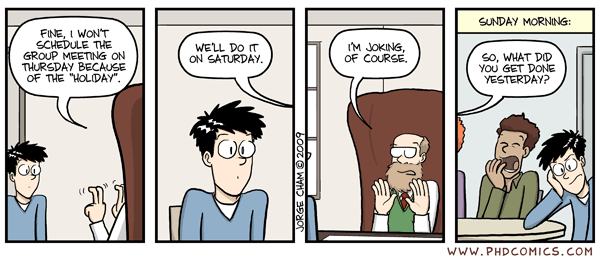Lab Meetings: The Secret Ingredient to a Great Research Experience
Why the Way a Lab Meets Is Just as Important as the Research Itself
The size of a research group isn’t just a number—it’s a game-changer. Whether you're in a tight-knit squad of fewer than ten, a mid-sized team of up to twenty, or a full-fledged research army of forty, the group’s dynamics will shape your Ph.D. (or postdoc, internship, or lab experience) in ways you probably haven’t even considered. Yet, when choosing a lab, most people focus on the topic, the funding, or the reputation of the PI. But what about the social dynamics? The hierarchy? The way meetings are run? Trust me—this stuff matters.
Lab Size: The Hidden Factor That Determines Everything
Every lab has a leader—the PI—who either directly manages Ph.D. students and postdocs (in smaller groups) or delegates responsibilities to senior postdocs or researchers (in larger groups). While no two labs are exactly alike, one constant remains: the way members interact and communicate makes or breaks the experience.
And nothing reveals these dynamics quite like lab meetings.
A well-run meeting can spark creativity, push your critical thinking to new levels, and bring a real sense of collaboration. A bad one? It’s an unstructured time-suck that leaves you frustrated and wondering why you even showed up. Yet, when was the last time you heard someone choosing a lab ask, “How often do you meet? What’s the format?” It’s one of the most overlooked aspects of lab life—until you’re stuck in a cycle of chaotic or mind-numbingly dull meetings.
If you don't know PhD Comics, you need to fix that right away. Click this link and enjoy!
Striking the Perfect Meeting Balance
Meet too little, and you’re lost in the dark, unsure of progress, and lacking feedback. Meet too often, and it becomes a micromanagement nightmare, where your workflow is constantly interrupted. The sweet spot? A structured, meaningful schedule that fosters discussion without eating up precious research time.
Weekly Must-Meetings
Journal Club (JC) – 1 hour
When? Early in the week (Monday/Tuesday), either at 9 AM or lunchtime.
How? Two approaches:Standard JC: One person presents the paper, and everyone else listens and discusses.
Active JC: Everyone reads the paper in advance. The presenter introduces it, but the real magic happens when the group dissects it together, figure by figure. It’s more engaging, but yes, it means a little more work. Worth it? Absolutely.
Advantages? Keeping up with the literature (as I discussed here Paper Bombing: The Art of Not Drowning in Scientific Literature)
One-on-One Meetings with the Supervisor – 1-2 hours
When? Flexible throughout the week.
Why?To stay organized and plan experiments effectively.
To keep the supervisor in the loop—without the dreaded micromanagement.
To create accountability and motivation (nothing like a weekly meeting to keep you moving!).
If I ever become a PI, these will be non-negotiable. Having lacked this structure myself, I know firsthand how easy it is to feel unmoored in the sea of experiments, lost in your own oscillating motivation. This meeting is the anchor every Ph.D. student needs.
Biweekly or Weekly (Depending on Lab Size)
Lab Meetings – 2-3 hours
When? Thursday or Friday afternoons.
What’s the deal?One member presents their latest data.
Everyone else asks questions, offers feedback, and engages in discussion.
If done right, this is your pre-conference training ground—where you refine your ability to present, answer tough questions, and think critically about data.
Depending on the size of the lab, a person ends up leading a lab meeting once every 2-3 months—perfect for having enough time to collect new data to present.
Subgroup Meetings (for bigger labs)
When? Flexible throughout the week.
Why? If the lab is large and divided into thematic mini-groups, these sessions keep collaborations tight and ideas flowing. It’s essentially a scaled-up one-on-one but for small teams working on interconnected projects.
Monthly Must-Have: The Special Seminar
Guest Speaker Seminars
Why?A chance to bring in external experts who can offer fresh perspectives and potential collaborations.
The guest meets with individual lab members, providing an outside view on ongoing projects.
A prime networking opportunity. (You never know when a seminar guest might turn into a future collaborator).
What’s Missing?
This is the meeting structure I’d aim for if I were running a lab—but I know there are plenty of other creative approaches out there. What have you seen that works (or doesn’t)? How does your lab structure meetings, and would you change it? Let’s get the conversation going!
Thanks for reading,
Best,
LoA





I don’t really have lab meetings as such, but weekly meetings with my supervisor, then every second week a group meeting with all three of my direct supervisors. I set the agenda and lead all of these meetings. It’s a cross disciplinary team of science/education/medicine. I attend some student groups, university groups (all remote as I am 20 hours of land/sea travel away from my university). I have far less meetings that when I worked in academia when some days it was only a short lunch break with back to back meetings. It was too much.
I’ve found the sweet spot for group meetings - one person presents, and in a smaller lab everyone gives short updates and can get feedback and help from others - to be Thursdays or Tuesdays. That leaves Friday to set you up for the next week without forgetting what was said or Monday to recall what you did last week (if you hopefully took a break over the weekend). Wednesday just feels like it really breaks the week up with not enough time on either end to get things done